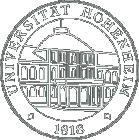
Hohenheim
Centre for Agriculture in
the Tropics and Subtropics

This poster was presented at the 6th Asian Fisheries Forum, 25-30 Nov. 2001, Kaohsiung, Taiwan (Book of Abstracts: p. 80)
 |
Universität Hohenheim |
TROZ Centre for Agriculture in the Tropics and Subtropics |
 |
| Section: Animal Nutrition and Aquaculture | |||
Milkfish (Chanos chanos Forsskål) is the most important cultured finfish species in the Philippines. One of the management methods used in milkfish pond culture is the modified Taiwanese method, where fish of around 50 g are added to the stock every 6 to 8 weeks in order to have different size classes in the pond simultaneously. It has often been claimed, that the food items ingested by milkfish differ according to the size of the fish. Therefore using the modified Taiwanese method might reduce diet competition between fish and enable the resource "natural food" to be used optimally. The goal of this study was to look at the dietary overlap between different size classes present in brackishwater ponds used for grow-out according to the modified Taiwanese method.
A commercially managed pond (9 ha) was monitored in Banate, Iloilo, Philippines, in July 1998 (wet season). Growth of natural food was enhanced by fertilization. No supplemental feed was given to the fish. During monitoring, 71 milkfish were caught using a cast-net every other hour (3 fish each) over a period of 48 hours, thus covering all hours of the day. Of the fish caught, 47 had stomach contents. The milkfish were divided into three weight-classes (< 100 g, 100-200 g, > 200 g). Fish, stomachs and guts were measured and weighed to the nearest mm and 0.1 g respectively. Stomachs were removed and preserved in 70% alcohol. The stomach contents were later analysed microscopically according to the percentage of the microscope slide covered by each of the main diet components. |
|
Tab. 1: Contribution of different food components as a percentage of total stomach contents within three different weight classes
| BM+ in g | n | Chlorophyta | Cyanophyta | Diatoma | Crustacea | Others++ | Detritus |
|---|---|---|---|---|---|---|---|
| < 100 | 13 | 3.1±4.8 | 15.4±8.5 | 4.6±7.8 | 3.5±6.9 | 14.2±14.7 | 59.2±14.8 |
| 100-200 | 26 | 2.9±4.3 | 20.8±9.2 | 6.9±8.1 | 1.9±6.9 | 7.5±7.8 | 60.0±11.0 |
| > 200 | 8 | 5.0±7.1 | 20.0±8.0 | 5.0±8.0 | 0 | 12.5±16.7 | 57.5±13.6 |
| +BM = Body mass; ++Others = nauplii, gastropoda, bivalvia and parts of macrophyta | |||||||
The relative sizes of the stomachs were the same in all groups (39% of total body length). None of the dietary items of the fish in any of the three weight-classes were significantly different (DMRT) and there was therefore no evidence of any size-selective feeding in the monitored milkfish pond. On the basis of these results it cannot be confirmed that multiple stocking increases the spectrum of dietary items utilised in the pond system.
|
 |